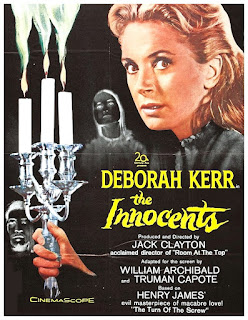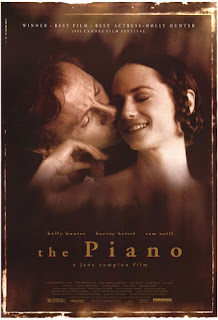October 25th: THE INNOCENTS (Jack Clayton, 1961)
NOTE: This film will be projected in the high-definition Blu-ray format.
A woman is hired to be the governess of two young orphans on a country estate which holds dark secrets.
Henry James, the esteemed American writer of the late 19th century, was a fan of ghost stories, and tried his hand at the genre with his 1989 novella The Turn of the Screw, heavily analyzed and interpreted by critics and academics and regarded as highly influential. British director Jack Clayton, coming off his Oscar-winning debut feature Room At The Top, was an admirer of James's story and had long been interested in adapting it.
Hollywood studio 20th Century Fox had acquired the rights by optioning a Broadway adaptation by playwright William Archibald, retitled The Innocents. Another Brit, dramatist and screenwriter John Mortimer was charged with instilling the script with authentic Victorian atmosphere, but the bulk of the writing would be done by American author Truman Capote, who brought his own sense of Southern Gothic and decadence to the proceedings, as well as conveying the Freudian, psychosexual subtext of the material.
The cast is headed by veteran Deborah Kerr (The King and I, Black Narcissus), playing a considerably younger woman, Michael Redgrave (Hitchcock's The Lady Vanishes), and child actors Martin Stephens (Village of the Damned) and Pamela Franklin (The Prime of Miss Jean Brodie). Clayton did not show complete scripts to the children in order to keep them ignorant of the story's darker elements.
The exteriors of the film were shot on location in East Sussex, particularly Sheffield Park Garden and Bluebell Railway. The interiors were all done at Shepperton Studios. Much to Clayton's chagrin, the studio insisted on using the widescreen Cinemascope format, not suited to the claustrophobic approach the director had intended. Cinematographer Freddie Francis (The Elephant Man) devised a way to blur and darken the edges of the frame with painted filters so as to reduce the essential area of the frame, but the two men also made great use of the widescreen during the outdoor scenes.
Clayton intended his film to be different stylistically from the current wave of British horror films from Hammer Studios, known for their bold colors and accentuation of blood and graphic violence. He took a page from the book of 1940s Hollywood producer Val Lewton (Cat People), who relied more on sound effects, suggestion, and the unseen over the seen to create his suspenseful atmospheres. With the help of editor Jim Clark, he made effective use of long dissolves and multiple overlapping images.
While not a box office success at the time, the film was well received by critics, appearing at the Cannes Film Festival, receiving a BAFTA nomination for Best Film, a Director's Guild of America nomination for Clayton, a National Board of Review win for Best Direction, and an Edgar mystery writers award for the screenplay. It is now recognized as a landmark of the horror genre, and counts Martin Scorsese, Guillermo del Toro, and Joe Dante among its fans.
Running time is 100 minutes.
A woman is hired to be the governess of two young orphans on a country estate which holds dark secrets.
Henry James, the esteemed American writer of the late 19th century, was a fan of ghost stories, and tried his hand at the genre with his 1989 novella The Turn of the Screw, heavily analyzed and interpreted by critics and academics and regarded as highly influential. British director Jack Clayton, coming off his Oscar-winning debut feature Room At The Top, was an admirer of James's story and had long been interested in adapting it.
Hollywood studio 20th Century Fox had acquired the rights by optioning a Broadway adaptation by playwright William Archibald, retitled The Innocents. Another Brit, dramatist and screenwriter John Mortimer was charged with instilling the script with authentic Victorian atmosphere, but the bulk of the writing would be done by American author Truman Capote, who brought his own sense of Southern Gothic and decadence to the proceedings, as well as conveying the Freudian, psychosexual subtext of the material.
The cast is headed by veteran Deborah Kerr (The King and I, Black Narcissus), playing a considerably younger woman, Michael Redgrave (Hitchcock's The Lady Vanishes), and child actors Martin Stephens (Village of the Damned) and Pamela Franklin (The Prime of Miss Jean Brodie). Clayton did not show complete scripts to the children in order to keep them ignorant of the story's darker elements.
The exteriors of the film were shot on location in East Sussex, particularly Sheffield Park Garden and Bluebell Railway. The interiors were all done at Shepperton Studios. Much to Clayton's chagrin, the studio insisted on using the widescreen Cinemascope format, not suited to the claustrophobic approach the director had intended. Cinematographer Freddie Francis (The Elephant Man) devised a way to blur and darken the edges of the frame with painted filters so as to reduce the essential area of the frame, but the two men also made great use of the widescreen during the outdoor scenes.
Clayton intended his film to be different stylistically from the current wave of British horror films from Hammer Studios, known for their bold colors and accentuation of blood and graphic violence. He took a page from the book of 1940s Hollywood producer Val Lewton (Cat People), who relied more on sound effects, suggestion, and the unseen over the seen to create his suspenseful atmospheres. With the help of editor Jim Clark, he made effective use of long dissolves and multiple overlapping images.
While not a box office success at the time, the film was well received by critics, appearing at the Cannes Film Festival, receiving a BAFTA nomination for Best Film, a Director's Guild of America nomination for Clayton, a National Board of Review win for Best Direction, and an Edgar mystery writers award for the screenplay. It is now recognized as a landmark of the horror genre, and counts Martin Scorsese, Guillermo del Toro, and Joe Dante among its fans.
Running time is 100 minutes.










Comments
Post a Comment